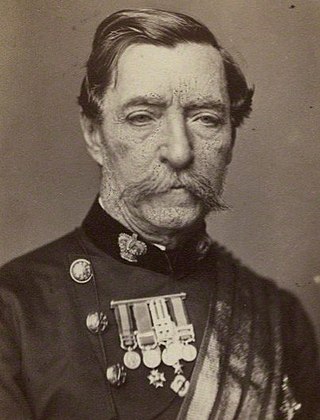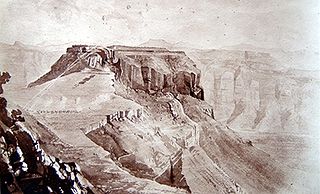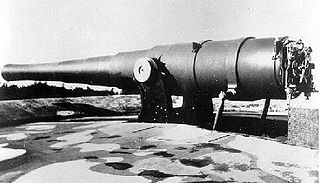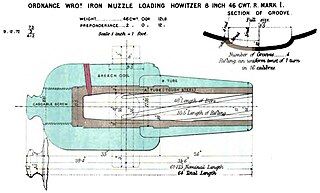
Field Marshal Robert Cornelis Napier, 1st Baron Napier of Magdala was a British Indian Army officer. He fought in the First Anglo-Sikh War and the Second Anglo-Sikh War before seeing action as chief engineer during the second relief of Lucknow in March 1858 during the Indian Rebellion of 1857. He also served in the Second Opium War as commander of the 2nd division of the expeditionary force which took part in the Battle of Taku Forts, the surrender of Peking's Anting Gate and the entry to Peking in 1860. He subsequently led the punitive expedition to Abyssinia July 1867, defeating the Emperor Tewodros II of Ethiopia with minimal loss of life among his own forces and rescuing the hostages of Tewodros.

The Rinella Battery was a Victorian battery in Kalkara, Malta. It is commonly referred to as Fort Rinella, although it was never classified as a fort while in use. It was armed with an Armstrong 100-ton gun, which survives; the only other surviving gun is at the Napier of Magdala Battery, Gibraltar.

Fort Saint Rocco, also known as Fort Saint Roca on some maps, is a polygonal fort in Kalkara, Malta. It is located east of Rinella Battery and seaward of the village of Santu Rokku, and forms part of the complex of shore batteries built by the British to defend the coast east of the mouth of Grand Harbour between the 1870s and 1900s.

The British Expedition to Abyssinia was a rescue mission and punitive expedition carried out in 1868 by the armed forces of the British Empire against the Ethiopian Empire. Emperor Tewodros II of Ethiopia, then often referred to by the anglicized name Theodore, imprisoned several missionaries and two representatives of the British government in an attempt to force the British government to comply with his requests for military assistance. The punitive expedition launched by the British in response required the transportation of a sizeable military force hundreds of kilometres across mountainous terrain lacking any road system. The formidable obstacles to the action were overcome by the commander of the expedition, General Robert Napier, who captured the Ethiopian capital, and rescued all the hostages.

The Battle of Magdala was the conclusion of the British Expedition to Abyssinia fought in April 1868 between British and Abyssinian forces at Magdala, 390 miles (630 km) from the Red Sea coast. The British were led by Robert Napier, while the Abyssinians were led by Emperor Tewodros II.

The 100-ton gun was a 17.72-inch (450 mm) rifled muzzle-loading (RML) gun made by Elswick Ordnance Company, the armaments division of the British manufacturing company Armstrong Whitworth, owned by William Armstrong. The 15 guns Armstrong made were used to arm two Italian battleships and, to counter these, British fortifications at Malta and Gibraltar.

The BL 9.2-inch Mk I–VII guns were a family of early British heavy breechloading naval and coast defence guns in service from 1881 to the end of World War I. They were originally designed to use the old gunpowder propellants.

The RML 10-inch guns Mk I – Mk II were large rifled muzzle-loading guns designed for British battleships and monitors in the 1860s to 1880s. They were also fitted to the Bouncer and Ant-class flat-iron gunboats. They were also used for fixed coastal defences around the United Kingdom and around the British Empire until the early years of the 20th century.

The RML 9-inch guns Mark I – Mark VI were large rifled muzzle-loading guns of the 1860s used as primary armament on smaller British ironclad battleships and secondary armament on larger battleships, and also ashore for coast defence. It should not be confused with the RML 9-inch Armstrong Gun, used by the Dutch navy, the Spanish Navy, and other navies.

The RML 12.5-inch guns were large rifled muzzle-loading guns designed for British battleships and were also employed for coast defence.

Parson's Lodge Battery is a coastal battery and fort in the British Overseas Territory of Gibraltar.

Rosia Bay is the only natural harbour in Gibraltar, the British Overseas Territory at the southern end of the Iberian Peninsula. Formerly referred to as Rosia Harbour, it is located on the southwest side of Gibraltar. Rosia Bay was the site of the Royal Navy Victualling Yard complex which was constructed in the early 19th century, allowing vessels to anchor and obtain provisions, including food and water. Vice Admiral Horatio Nelson obtained supplies for his Mediterranean Fleet at Rosia Bay. It was to that same anchorage that his vessel HMS Victory was towed after Nelson's death in the 1805 Battle of Trafalgar. The area is also the location of gun batteries, including Parson's Lodge Battery at the south end of the bay and Napier of Magdala Battery at the north end. In the 21st century, Rosia Bay was the focus of controversy following the government's demolition of the historic Rosia Water Tanks and construction of the affordable housing development Nelson's View, which necessitated the relocation of the owners of the adjacent 19th century Rosia Cottages.

The Gibraltar Heritage Trust is a non-profit charity established by statute on 1 May 1989 to preserve and promote the cultural natural heritage of the British Overseas Territory of Gibraltar.
Victoria Battery was an artillery battery in the British Overseas Territory of Gibraltar. It was notable for being one of the two batteries in Gibraltar to mount a 100-ton gun.

The Gibraltar peninsula, located at the far southern end of Iberia, has great strategic importance as a result of its position by the Strait of Gibraltar where the Mediterranean Sea meets the Atlantic Ocean. It has repeatedly been contested between European and North African powers and has endured fourteen sieges since it was first settled in the 11th century. The peninsula's occupants – Moors, Spanish, and British – have built successive layers of fortifications and defences including walls, bastions, casemates, gun batteries, magazines, tunnels and galleries. At their peak in 1865, the fortifications housed around 681 guns mounted in 110 batteries and positions, guarding all land and sea approaches to Gibraltar. The fortifications continued to be in military use until as late as the 1970s and by the time tunnelling ceased in the late 1960s, over 34 miles (55 km) of galleries had been dug in an area of only 2.6 square miles (6.7 km2).

The fortifications of Malta consist of a number of walled cities, citadels, forts, towers, batteries, redoubts, entrenchments and pillboxes. The fortifications were built over hundreds of years, from around 1450 BC to the mid-20th century, and they are a result of the Maltese islands' strategic position and natural harbours, which have made them very desirable for various powers.

Cambridge Battery is a Victorian-era battery in Sliema, Malta. It is commonly referred to as Fort Cambridge, although it was never classified as a fort while in use. It originally contained an Armstrong 100-ton gun.

The RML 8-inch howitzer was a British Rifled, Muzzle Loading (RML) Howitzer manufactured in England in the 19th century, which fired a projectile weighing approximately 180 pounds (82 kg). It was used in siege batteries and in fortifications.

Imperial fortress was the designation given in the British Empire to four colonies that were located in strategic positions from each of which Royal Navy squadrons could control the surrounding regions and, among them, much of the planet.






















